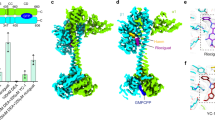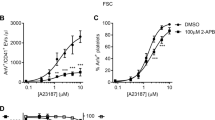Abstract
The potent inducer of platelet aggregation, ADP, inhibits both basal and stimulated cyclic AMP production in intact platelets1,2. However, several attempts have failed to detect an effect of the nucleotide on adenylate cyclase activity in broken cell preparations2,3. This paradox has led to suggestions that ADP may act on unidentified sites before the adenylate cyclase step, such as a nucleoside diphosphate kinase4 and a Ca2+ transport system5,6. It is difficult to demonstrate the effect of physiologically effective concentrations (0.1–5 µM) of ADP on a crude membrane preparation of adenylate cyclase because of the presence of nucleoside phosphohydrolase activities which may degrade either the substrate ATP or the putative effector ADP to products (such as ADP, AMP and adenosine) displaying diverse effects. A substrate regenerating system which converts ADP to ATP obviously provides no solution. The contamination by adenine nucleotides and catecholamines in widely used crude lysate preparations aggravates the problem7–9. Using a purified human platelet plasma membrane preparation, and the non-hydrolysable ATP analogue APP(NH)P as substrate, we have now demonstrated direct inhibition of adenylate cyclase by ADP in the physiologically effective concentration range. The inhibitory effect of ADP is immediate in onset and is equal to that produced by adrenaline; it is shared by ADP-βS (and 2′-deoxy ADP to some extent) but not by AP(CH2)P or other adenine nucleotides. The Ki, for ADP is ∼ 0.3 µM and maximal inhibition is observed at 2 µM
This is a preview of subscription content, access via your institution
Access options
Subscribe to this journal
Receive 51 print issues and online access
$199.00 per year
only $3.90 per issue
Buy this article
- Purchase on Springer Link
- Instant access to full article PDF
Prices may be subject to local taxes which are calculated during checkout
Similar content being viewed by others
References
Cole, B., Robison, A. & Hartmann, R. C. Ann. N.Y. Acad. sci. 185, 477–487 (1971).
Haslam, R. J., Davidson, M. M. L., Davies, T., Lynham, J. A. & McClenaghan, M. D. Adv. cyclic Nucleotide Res. 9, 533–552 (1978).
Salzman, E. W. & Levine, L. J. clin. Invest. 50, 131–141 (1971).
Mustard, J. F., Packham, M. A., Perry, D. W., Guccione, M. A. & Kinlough-Rathbone, R. L. Ciba Fdn Symp. 35, 47–75 (1975).
Kazer-Glanzmann, R., Jakabova, M., George, J. N. & Luscher, E. F. Biochim biophys. Acta 466, 429–440 (1977).
Haslam, R. J. Ciba Fdn Symposium 35, 121–151 (1975).
Lee, G. R., Boggs, D. R., Bithell, T. C., Athens, J. W. & Foerster, J. (eds) Clinical Haematology 7th edn 372–408. (Kimpton, London, 1974).
Jakobs, K. H., Saur, W. & Schultz, G. FEBS Lett. 85, 167–170 (1978).
Haslam, R. J., Davidson, M. M. L. & Desjardins, J. V. Biochem. J. 176, 83–95 (1978).
Barber, A. J. & Jamieson, G. A. J. biol. Chem. 245, 6357–6365 (1970).
Salomon, Y., Londos, C. & Rodbell, M. Analyt. Biochem. 58, 541–548 (1974).
Randerath, K. & Randerath, E. J. Chromatogr. 16, 111–129.
Horak, H. & Barton, P. G. Biochim. biophys. Acta 373, 471–480 (1974).
Gough, G., Maguire, M. H. & Penglis, F. Molec. Pharmac. 8, 170–177 (1972).
Myers, T. C., Nakamura, K. & Danielson, A. B. J. org. Chem. 30, 1517–1520 (1965).
Londos, C., Cooper, D. M. F., Schlegel, W. & Rodbell, M. Proc. natn. Acad. Sci. U.S.A. 75, 5362–5366 (1978).
Sabol, S. L. & Nirenberg, M. J. biol. Chem. 254, 1913–1920 (1979).
Born, G. V. R. J. Physiol., Lond. 209, 487–511 (1970).
Londos, C. & Wolff, J. Proc. natn. Acad. Sci. U.S.A. 74, 5482–5486 (1977).
Burnstock, G. in Physiological and Regulatory Functions of Adenosine and Adenine Nucleotides (eds Baer, H. P. & Drummond, G. I.) 3–32 (Raven, New York, 1979).
Lin, M. C., Salomon, Y., Rendell, M. & Rodbell, M. J. biol. Chem. 250, 4246–4252 (1975).
Author information
Authors and Affiliations
Rights and permissions
About this article
Cite this article
Cooper, D., Rodbell, M. ADP is a potent inhibitor of human platelet plasma membrane adenylate cyclase. Nature 282, 517–518 (1979). https://doi.org/10.1038/282517a0
Received:
Accepted:
Published:
Issue Date:
DOI: https://doi.org/10.1038/282517a0
This article is cited by
-
Blood cells: an historical account of the roles of purinergic signalling
Purinergic Signalling (2015)
-
P2 receptors in atherosclerosis and postangioplasty restenosis
Purinergic Signalling (2007)
-
P2 receptors in atherosclerosis and postangioplasty restenosis
Purinergic Signalling (2006)
-
Delineation of ligand binding and receptor signaling activities of purified P2Y receptors reconstituted with heterotrimeric G proteins
Purinergic Signalling (2004)
-
P2 receptors: new potential players in atherosclerosis
British Journal of Pharmacology (2002)
Comments
By submitting a comment you agree to abide by our Terms and Community Guidelines. If you find something abusive or that does not comply with our terms or guidelines please flag it as inappropriate.



